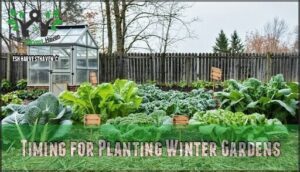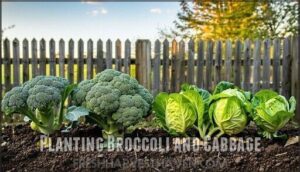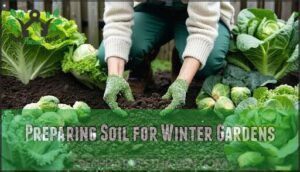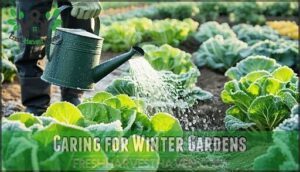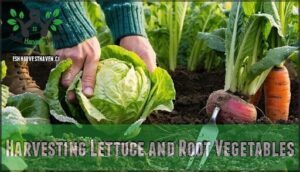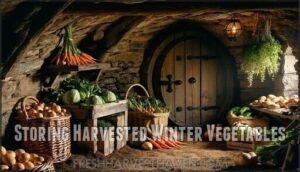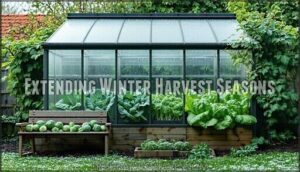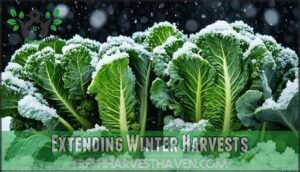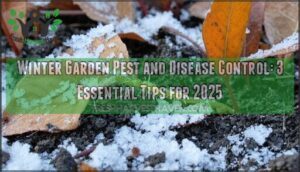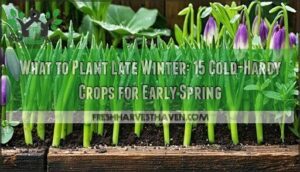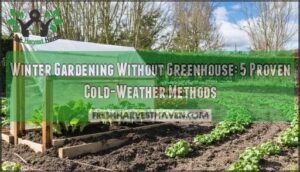This site is supported by our readers. We may earn a commission, at no cost to you, if you purchase through links.
 Cold weather gardening lets you grow fresh vegetables year-round by choosing hardy varieties that thrive in freezing temperatures.
Cold weather gardening lets you grow fresh vegetables year-round by choosing hardy varieties that thrive in freezing temperatures.
These resilient crops—like kale, Brussels sprouts, carrots, and winter radishes—actually develop sweeter flavors after frost hits. They’re nature’s little survivalists, producing natural antifreeze compounds that protect their cells from cold damage.
Winter gardening offers surprising perks: fewer pests, less watering, and vegetables with concentrated sugars that taste better than their summer counterparts.
You’ll need proper timing and some season-extending tricks, but once you master these cold-hardy champions, you’ll wonder why you ever stopped gardening when temperatures dropped, and enjoy the sweeter flavors and concentrated sugars of your harvest.
Table Of Contents
- Key Takeaways
- Cold Weather Gardening Basics
- Planting Winter Gardens
- Caring for Winter Gardens
- Harvesting Winter Gardens
- Extending Winter Harvests
- Frequently Asked Questions (FAQs)
- How cold is too cold for a garden?
- What vegetables can grow in cold weather?
- What month do you plant a winter garden?
- Can you garden in cold weather?
- What vegetables grow best in a cold climate?
- What is the best plant for cold weather?
- What month do you start a winter garden?
- What is the winter gardening method?
- How to garden in cold climates?
- What vegetables grow best in the cold?
- Conclusion
Key Takeaways
- You’ll grow sweeter vegetables – Cold-hardy crops like kale, carrots, and Brussels sprouts actually develop better flavor after frost hits, converting starches into natural sugars that make winter harvests taste superior to summer produce.
- You can garden year-round – Winter gardening extends your growing season indefinitely by selecting frost-tolerant varieties that survive temperatures as low as 10°F, providing fresh vegetables when grocery stores offer expensive, lower-quality options.
- You’ll face fewer garden problems – Cold weather gardening means dealing with fewer pests, less frequent watering, and reduced disease pressure compared to summer growing, making maintenance easier and more predictable.
- You’ll need proper timing and protection – Success requires planting cold-hardy varieties in late summer (July-August), using season-extending techniques like row covers and cold frames, and understanding your local frost dates to maximize harvests.
Cold Weather Gardening Basics
Winter gardening transforms your growing season from a brief summer sprint into a year-round marathon of fresh produce.
You’ll discover that cold-hardy vegetables but also survive freezing temperatures and actually improve in flavor when kissed by frost, converting starches into natural sugars that make your harvest sweeter than any summer crop.
Choosing Vegetables for Winter
When winter arrives, your vegetable selection determines garden success.
You’ll need frost-tolerant varieties that thrive in cold weather gardening conditions. Smart seasonal planning focuses on cold hardy vegetables that withstand freezing temperatures and deliver fresh harvests through winter months.
Consider these winter vegetable gardening essentials:
- Brassica powerhouses – Kale and Brussels sprouts survive down to 5°F
- Root crop champions – Carrots and beets sweeten after frost exposure
- Leafy green survivors – Spinach and Swiss chard bounce back from snow
- Allium anchors – Garlic and leeks tolerate repeated freeze-thaw cycles
For best results, understanding winter gardening tips is key for a successful harvest.
Characteristics of Cold Hardy Vegetables
Understanding frost tolerance helps you select the right crops for your winter garden.
Cold hardy vegetables possess specific adaptations that allow them to survive freezing temperatures, converting starches to sugars when exposed to frost.
| Frost Tolerance Level | Temperature Range | Example Vegetables |
|---|---|---|
| Frost Tender | Above 32°F (0°C) | Tomatoes, peppers, beans |
| Frost Tolerant | 26-32°F (-3 to 0°C) | Broccoli, lettuce, radishes |
| Freeze Tolerant | 10-26°F (-12 to -3°C) | Kale, spinach, Brussels sprouts |
| Extremely Hardy | Below 10°F (-12°C) | Collard greens, parsnips |
Root vegetables and cool season crops typically show the best cold hardiness, making them ideal winter harvest candidates.
To enhance their growth, gardeners should focus on cold climate strategies that improve soil quality and structure.
Vegetable Varieties for Cold Weather
Selecting the right frost tolerant varieties transforms your winter garden from wishful thinking to reliable harvest.
Cold hardy vegetables like ‘Packman’ broccoli mature in 55 days, while ‘Gonzales’ cabbage produces softball-sized heads in 60 days.
These winter crops thrive when you match varieties to your growing conditions.
- ‘Red Sails’ lettuce delivers gorgeous reddish-bronze leaves ready in just 45 days
- ‘Thumbelina’ carrots win awards for their sweet, bite-sized perfection in cold soil
- ‘Earliana’ cabbage gives you spring harvests when fresh vegetables feel like gold
Planting Winter Gardens
You’ll want to start your winter garden planning well before the first frost hits your area.
The key is timing your plantings so hardy vegetables like broccoli and cabbage mature during cool weather rather than summer heat.
Timing for Planting Winter Gardens
Perfect timing beats perfect plants every time.
Mother Nature doesn’t check her watch when frost arrives.
Count backward from your first expected frost date—typically 10-14 weeks for most cold weather crops.
Winter sowing works best when you plant frost hardy plants in late summer, giving them time to establish before winter’s grip tightens.
Your planting schedules should align with local frost dates, not calendar dates, since Mother Nature doesn’t check her watch.
Understanding the right winter garden seeds is essential for a successful winter garden.
Planting Broccoli and Cabbage
Successfully transplant broccoli and cabbage seedlings when they’re 4-6 weeks old, typically in late summer for fall harvests.
Space broccoli plants 12-18 inches apart in rows, while cabbage varieties like ‘Earliana’ need 12-15 inches between plants.
These cool season gardening champions thrive in temperatures between 60-65°F, making them perfect frost tolerant plants for your winter garden.
Understanding soil temperature is essential for the success of these plants in cold weather, and they are great for a winter garden.
Preparing Soil for Winter Gardens
Before winter’s grip tightens on your garden, proper soil preparation becomes your foundation for success.
Testing soil pH in late summer reveals nutrient deficiencies that’ll affect your cold-weather crops throughout the season.
- Add 2-4 inches of organic matter to boost microbial activity and nutrient retention
- Apply lime when pH drops below 6.0 to improve nutrient availability for winter vegetables
- Incorporate composted manure in autumn to enhance nitrogen levels for sustained growth
- Create raised beds in freeze-thaw regions to maintain better soil structure and drainage
Caring for Winter Gardens
Once your winter vegetables are established, they’ll need consistent care to thrive through cold months.
You’ll want to monitor sunlight exposure, maintain proper watering schedules, and protect plants from frost damage using mulch and pest management strategies.
Providing Adequate Sunlight and Water
Most cold-hardy vegetables thrive with six sunlight hours daily, though leafy greens tolerate partial shade.
Monitor soil moisture levels carefully—winter’s deceptive dryness can stress frost tolerant plants. Water conservation becomes vital when irrigation systems freeze, so deep watering before cold snaps helps cold hardy plants survive.
Proper hydration guarantees your cold climate gardening efforts flourish through winter’s challenges. To further protect plants, consider applying mulch effectively.
Mulching for Winter Garden Protection
Beyond proper watering, your winter garden needs a protective blanket. Organic mulch acts as winter insulation, stabilizing soil temperature and providing essential frost protection.
Apply 2-4 inches after the first hard frost, keeping material away from plant stems to prevent disease buildup.
Essential Winter Mulching Steps:
- Choose the right materials – Straw, shredded leaves, or pine needles work best for cold climate gardening
- Time application correctly – Wait until after first hard frost to prevent rodent nesting
- Maintain proper depth – 2-4 inches provides ideal winter garden maintenance without causing rot
- Create spacing – Keep mulch several inches from stems to allow air circulation around frost tolerant plants
This garden bedding strategy reduces soil erosion by 50% while maintaining consistent root zone temperatures. Your cold frame gardening efforts will benefit from this simple yet effective frost protection method.
Using the right organic mulch products is vital for successful winter gardening.
Managing Winter Garden Pests and Diseases
Winter gardens face unique challenges that require targeted pest management strategies.
Aphids and cabbage worms often persist in cold weather, targeting your frost-resistant plants. Apply organic insecticidal soap every two weeks for effective pest control.
Remove diseased plant debris immediately to prevent fungal spread—winter sanitation is your best defense.
Cold-hardy varieties naturally show better disease resistance, but monitor for powdery mildew and black rot regularly.
Harvesting Winter Gardens
You’re about to discover that harvesting winter vegetables isn’t just a chore—it’s a science experiment where frost can sweeten kale and carrots right under your nose.
Just remember, monitoring soil temperatures and timing your harvest before a hard freeze guarantees you get crisp lettuce and perfectly stored roots, even if your gloves get muddy.
Harvesting Lettuce and Root Vegetables
When harvesting lettuce and root vegetables during cold weather gardening, timing becomes your greatest ally.
Lettuce harvest works best in early morning when leaves are crisp and hydrated.
Root crops like carrots and beets can remain in frozen ground until needed, as frost timing actually improves their sweetness.
Use winter foraging techniques to check soil conditions before digging, ensuring easier extraction and better cold storage preparation.
Storing Harvested Winter Vegetables
Once you’ve gathered your winter harvest, proper storage maximizes your vegetables’ shelf life and nutritional value.
Root cellars provide ideal conditions with consistent temperatures and humidity levels for winter vegetable storage.
Essential winter preservation techniques include:
- Curing techniques – Dry winter squash and onions before storing to toughen skins
- Cold storage techniques – Maintain 32-40°F temperatures with high humidity for root vegetables
- Freezer methods – Blanch vegetables before freezing to preserve quality and nutrients
Store carrots in moist sand, keep potatoes in darkness to prevent sprouting, and use perforated bags for cabbage.
Proper coldweather crop management prevents spoilage and extends your harvest benefits.
Extending Winter Harvest Seasons
Smart gardeners know that cold frames act like mini-greenhouses, trapping warmth to extend harvest seasons well into winter.
These simple structures, combined with row covers and mulching, create microclimates that protect frost-tolerant plants.
Strategic crop rotation and succession planting guarantee continuous harvests through season extension techniques that maximize your winter gardening success.
By utilizing effective season extension methods, gardeners can enjoy a longer and more productive growing season.
Extending Winter Harvests
You can substantially extend your winter harvest season by using protective structures and strategic techniques that shield plants from harsh weather.
These methods create microclimates that keep vegetables growing productively even when temperatures drop well below freezing, which is a key factor in having a successful winter harvest with protective structures.
Using Row Covers and Cold Frames
Row covers and cold frames effectively extend your growing season by creating protective microclimates.
Row Cover Materials like lightweight fabric increase soil temperature by 2-6°F while allowing light penetration.
Cold Frame Designs trap heat, raising temperatures 5-10°F above outdoor conditions.
These frost protection methods reduce wind damage and pest issues, boosting winter vegetable yields up to 30% through strategic Season Extension techniques.
Gardeners can utilize row cover products to improve their winter gardening results by using row cover products and understanding the importance of frost protection.
Building Greenhouses for Year-Round Harvest
When you’re ready to take cold-season gardening seriously, greenhouses offer unmatched climate control and structural designs for year-round harvests.
Polycarbonate greenhouse materials provide superior insulation while aluminum frames guarantee durability.
Automated irrigation systems and soil management become effortless inside these controlled environments, eliminating the need for frost protection method guesswork completely, unlike hoop house gardening or cold frames.
Winter Gardening Tips and Techniques
Beyond greenhouses, mastering winter gardening tips requires strategic frost protection techniques.
Use cold frames for season extension and apply garden insulation around plant bases.
Winter pruning maintains plant health while proper soil conditioning prevents freeze damage.
Layer mulch for root protection and monitor soil moisture levels to ensure your frost tolerant plants and cold hardy plants thrive through harsh conditions.
Frequently Asked Questions (FAQs)
How cold is too cold for a garden?
Most vegetables stop growing when temperatures drop below 32°F, but freeze-tolerant crops like kale, Brussels sprouts, and carrots can survive down to 10-20°F with proper protection.
What vegetables can grow in cold weather?
Cold-hardy vegetables thrive in winter conditions! You can grow kale, spinach, Brussels sprouts, carrots, and collard greens in temperatures below freezing. These frost-tolerant crops actually taste sweeter after cold exposure.
What month do you plant a winter garden?
Michigan gardeners plant winter vegetables like kale in mid-July, ensuring sixty days before first frost.
You’ll plant winter crops between July-August for fall harvest, timing depends on your zone’s frost dates.
Can you garden in cold weather?
Yes, you can absolutely garden in cold weather! Many vegetables like kale, spinach, and carrots actually thrive in winter conditions. These cold-hardy crops tolerate frost and freezing temperatures remarkably well.
What vegetables grow best in a cold climate?
When winter’s harsh embrace threatens your garden dreams, you’ll find resilient warriors thriving in frigid conditions.
Kale, spinach, carrots, and Brussels sprouts tolerate freezing temperatures brilliantly, converting starches to sugars for enhanced sweetness.
They are resilient and can thrive in cold weather.
What is the best plant for cold weather?
You’ll find kale stands out as the ultimate cold-weather champion, thriving in temperatures as low as 10°F while actually becoming sweeter after frost exposure.
What month do you start a winter garden?
About 70% of vegetables can tolerate frost, making August your sweet spot for starting winter gardens.
You’ll plant cold-hardy crops like kale, spinach, and carrots in late summer to early fall for winter harvests.
What is the winter gardening method?
Cold-season planting involves selecting frost-tolerant varieties, protecting plants with row covers or cold frames, and timing plantings for fall harvest. You’ll extend growing seasons using succession planting techniques.
How to garden in cold climates?
Ever wondered why hardy vegetables taste better after frost?
You’ll succeed by choosing freeze-tolerant crops like kale, spinach, and carrots.
Use row covers for protection, plant in well-draining soil, and time plantings for your zone’s frost dates.
What vegetables grow best in the cold?
Kale, spinach, and Brussels sprouts thrive in freezing temperatures, actually becoming sweeter after frost exposure. Carrots, beets, and collard greens tolerate cold exceptionally well, surviving harsh winter conditions.
Conclusion
Mastering cold weather gardening transforms your relationship with seasonal growing cycles.
You’ll discover that frost-kissed vegetables offer superior nutrition and flavor profiles compared to their summer counterparts.
These hardy crops continue photosynthesis at temperatures that would devastate warm-season plants, proving nature’s remarkable adaptability.
With proper variety selection and protection techniques, your winter garden becomes a reliable source of fresh produce.
Cold weather gardening extends your growing season indefinitely, providing consistent harvests when grocery store prices peak and quality diminishes, offering a unique opportunity for superior nutrition and fresh produce.
- https://homesteadingfamily.com/gardening-in-winter-cold-weather-growing-methods/
- https://cast.desu.edu/sites/cast/files/document/16/10_22_gardening_with_cold_frames.pdf
- https://www.youtube.com/watch?v=hi9mM7BkKco
- https://www.almanac.com/best-vegetables-cool-weather
- https://www.thecelticfarm.com/winter-cold-plunge-for-plants/

